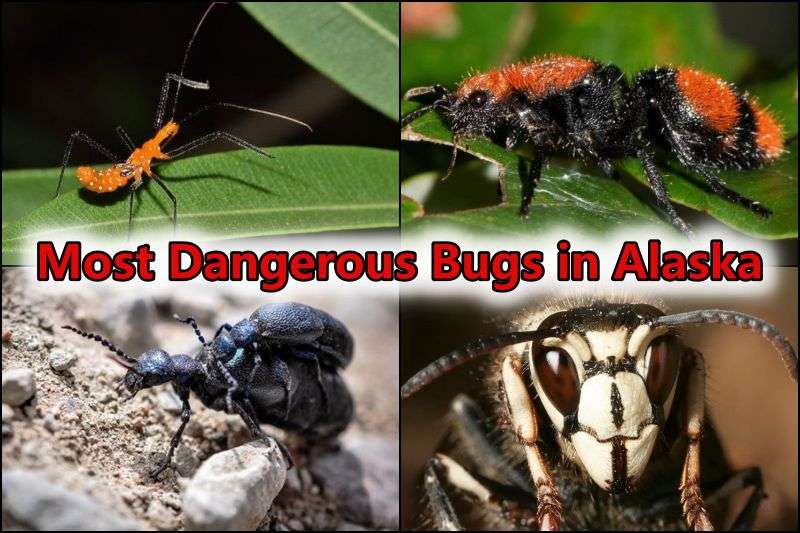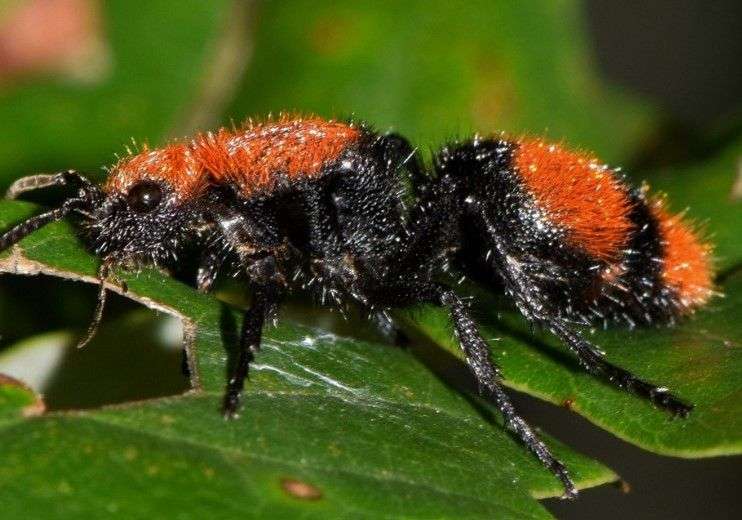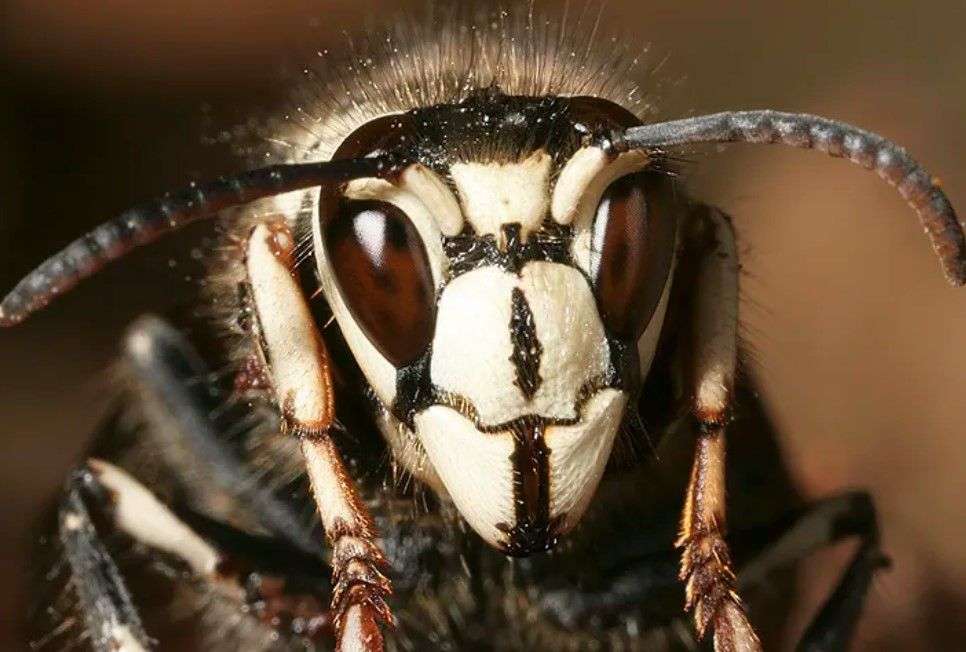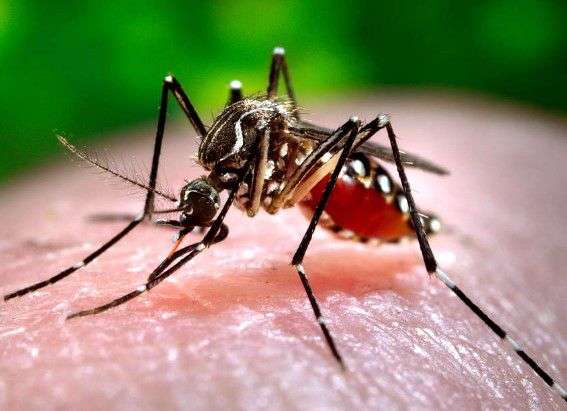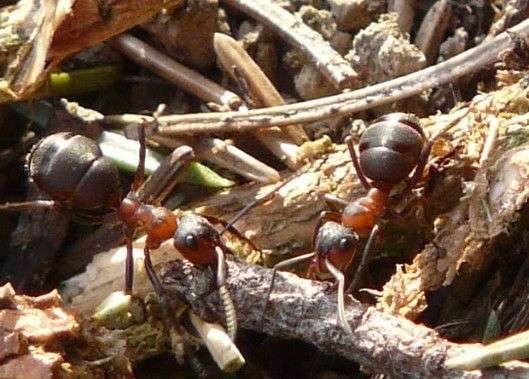Alaska, one of the biodiversity hotspots of the world, attracts hundreds of thousands of tourists all around the year who come to this majestic place to be one with its flora and fauna. However, they need to be careful of certain 6-legged natives that may inflict quite a harm. In today’s article, we bring to you 15 Dangerous Bugs in Alaska that may have a painful bite, a sting, or may be vectors of several deadly diseases. So without much ado, come and join me for an entomology tour of Alaska.
15 Dangerous Bugs in Alaska
1. Assassin’s Bug
| Common Name | Masked Hunter |
| Scientific Name | Reduvius personatus |
| Size | 0.75 inches |
| Habitat | Urban areas around buildings |
| Danger Level | High |
| Reason | Highly painful bites |
The Masked Hunter is a species of Assasin’s Bug that prefers dry places and therefore make its way indoors in search of warm, dry spots. These bugs are a nuisance, as their manhandling can lead to severely painful bites.
Handling them carelessly, especially by people who aren’t native to the place, especially tourists, are exposed to greater risks. Their bites may sometimes lead to anaphylactic reactions.
2. Eastern Velvet Ant
| Common Name | Cow Killer |
| Scientific Name | Dasymutilla occidentalis |
| Size | 2 centimeters |
| Habitat | Lawns, pastures, forests, gardens |
| Danger Level | High |
| Reason | Extremely Painful Sting |
Despite having the name Eastern Velvet Ants, these notorious creatures are wasps with a dense hairy covering on their bodies that gives them their characteristic velvet-like appearance.
Body colorations consist of a blasé black color with orange-red patterns. The red coloration serves as a warning sign that these insects can deliver such a painful bite, which rumors state can easily kill an adult cow.
3. Common Paper Wasp
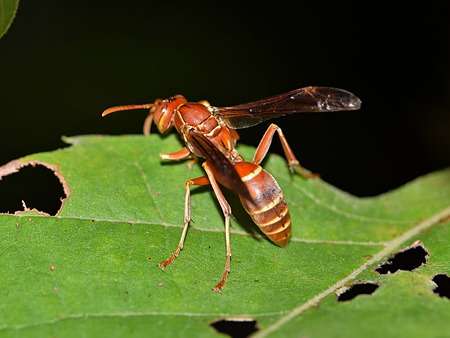
| Common Name | Common Paper Wasp, Guinea Wasp |
| Scientific Name | Polistes exclamans |
| Size | 2-4 centimeters |
| Habitat | In any place protected from rain |
| Danger Level | High |
| Reason | Sting causing excruciating pain (Schmidt Pain Level: 3) |
A notable species of Paper Wasps, the Guinea Paper Wasp is the 3rd member of this list covering dangerous bugs in Alaska. One can easily identify this species by its red color back and abdomen consisting of black, red, and yellow colored alternating bands.
Their sting can cause immense pain, coupled with redness and swelling, and can even be lethal to allergic and sensitive persons.
4. Yellow Jackets
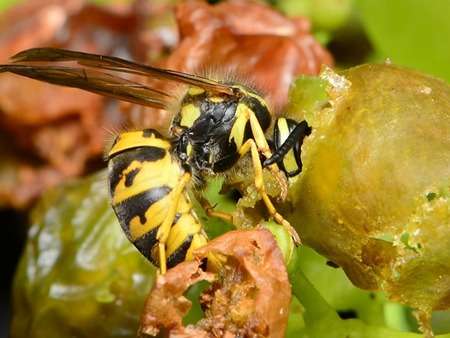
| Common Name | Common Yellowjacket |
| Scientific Name | Vespula alascensis |
| Size | 0.5 inches |
| Habitat | Forests, urban areas |
| Danger Level | Painful Sting |
| Reason | Pain, redness, itching, swelling |
The common yellow jackets are widespread throughout Alaska, and people prefer to maintain their distance due to their aggressiveness and potent sting.
Common Yellow jackets can easily be recognized by coloration, which consists of black and yellow colors. These wasps will inhabit any areas that have food in ample quantities, especially sugary foods.
Vegetation destruction and building towns haphazardly have led to a steep decline in their population.
5. Carpenter Ant
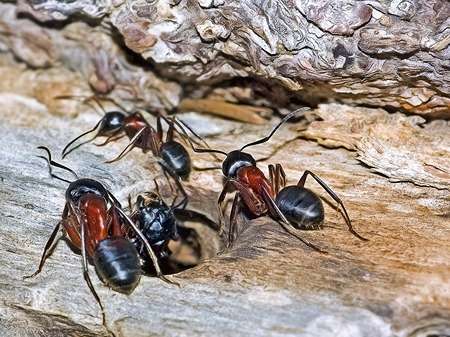
| Common Name | Carpenter Ants |
| Scientific Name | Camponotus spp. |
| Size | 0.3-1 inch |
| Habitat | Moist, woody forest environments |
| Danger Level | Moderately high |
| Reason | Large, and strong mandibles to deliver a nasty bite |
The next insects that can be counted among the dangerous bugs in Alaska are the carpenter ants. These large ant species get their name from their habit of excavating wood which in turn helps in the decomposition process of the forests.
Carpenter ants are both hunters as well as scavengers. Their diet comprises honeydew, nectar, other insects, or any dead matter.
6. Bald Faced Hornet
| Common Name | white-faced hornet, blackjacket, white-tailed hornet |
| Scientific Name | Dolichovespula maculata |
| Size | 0.75 inches |
| Habitat | Forests, meadows, urban areas where vegetation is available |
| Danger Level | High |
| Reason | Stings repeatedly, Schmidt’s Pain Index of 2 |
Despite not being “true hornets,” Bald-Faced Hornets are a close relative to yellow jackets. This species has a thick body, with a greater proportion of white on their bodies than black.
Bald-faced hornets primarily prey on insects and other yellow jackets; hordes of them are regarded as beneficial species, as they keep their population in check.
If they perceive a threat, Bald-faced hornets become very aggressive and tend to sting multiple times.
7. Western Bumblebee
| Common Name | Alaskan bumblebee |
| Scientific Name | Bombus occidentalis |
| Size | 1 inch |
| Habitat | Near flower beds, gardens, forests |
| Danger Level | Moderate |
| Reason | Painful sting, causing redness, swelling |
Despite being spread over three color morphs, the Western Bumblebee in Alaska is distinguishable by the yellow hairs behind its wings.
They are important pollinators and play a crucial role in maintaining the health of many ecosystems. Bumblebees are important pollinators and play a crucial role in maintaining the health of an ecosystem.
8. Four Spotted Velvet Ants
| Common Name | Velvet Ants |
| Scientific Name | Dasymutilla quadriguttata |
| Size | 2 centimeters |
| Habitat | Lawns, pastures, forests, gardens |
| Danger Level | High |
| Reason | Painful swelling |
The next insect on this list of bugs in Alaska is the Four Spotted Velvet Ant, a close relative of the Cow Killers. Though having the name Ants, these insects are wasps.
Distinguishing features of the Four Spotted Velvet Ants include a reddish head and an abdomen that displays four spots: 2 large and two small near the waist.
Harmless at first, Four Spotted Velvet ants, especially the females, become particularly aggressive and deliver extremely painful stings.
9. Allegheny Mound Ants
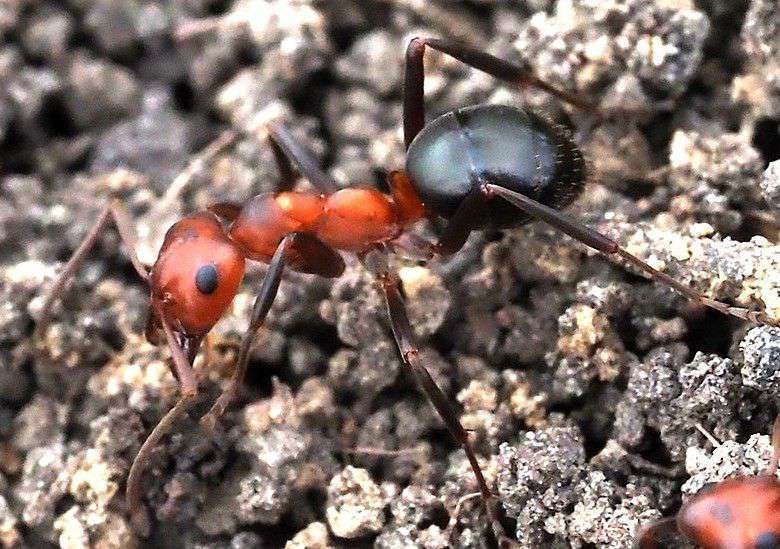
| Common Name | Mound ants, Formica ants |
| Scientific Name | Formica exsectoides |
| Size | 3.2-6.3 millimeters |
| Habitat | Fields, areas of open vegetation, meadows |
| Danger Level | Moderate |
| Reason | Bite, sprays formic acid |
Allegheny Mound Ants is a species of field ant that is quite distinguishable from its other relatives. A reddish-orange head and thorax and black to dark brown abdomen serve as their characteristic identifying features.
Mound ants are a nuisance as they strip the area around their mound of its vegetation by spraying formic acid. If threatened, they may cause a painful bite in addition to formic acid spray that causes itching and irritation.
10. Aedes Mosquito
| Common Name | Tomguito, Aedes mosquito |
| Scientific Name | Aedes vexans |
| Size | 1.8-3.2 millimeters |
| Habitat | everywhere |
| Danger Level | Moderate |
| Reason | Causes diseases like encephalitis, myxomatosis, meningitis |
Aedes Mosquito is a mosquito species with a cosmopolitan distribution. Though its bite may not be as potent as the other members of this list, the number of diseases it brings to the table makes it quite dangerous.
Many environmentalists state that the cold climate of Alaska and other geographical factors gives no chance to these mosquito-related diseases.
It is true to lot extent that diseases like dog heartworm, myxomatosis, and encephalitis are more tropical, yet we must not forget the changing climate of the world and the high evolution rate of insects and also the viruses they carry.
11. Red Pavement Ants

| Common Name | Pavement Ants |
| Scientific Name | Tetramorium caespitum |
| Size | 3-7 millimeters |
| Habitat | Along the sides of concrete pavements, walls, concrete slabs |
| Danger Level | Moderate |
| Reason | Bites causing painful, itchy swelling |
Remember the time when tiny red ants found up inside your shoe from the driveway or footpath and gave a nasty bite? It was painful, right?
This is exactly why we have Red Pavement Ants on this list of dangerous bugs in Alaska. Pavement ants are red or reddish brown in coloration and feed on almost anything which they find while foraging.
Though they do great work in keeping the surroundings clean, their huge numbers sometimes can cause severe infestations.
12. Formica Ants
| Common Name | Red Ants |
| Scientific Name | Formica sp. |
| Size | Variable; dependent on the species |
| Habitat | Almost everywhere |
| Danger Level | Moderate |
| Reason | Bites, formic acid sprays |
Formica ants bring underneath them a wide spectrum of ant species that we commonly encounter in our daily lives. These ants generally occur in red to reddish-brown coloration and are known for their painful bites.
Another characteristic of formica ants is that they have a high formic acid content in their bodies, which makes them highly acidic and unpalatable. Formica ants also use formic acid as a spray to deter foreign organisms.
13. Western Harvester Ants

| Common Name | Auburn Harvester Ants |
| Scientific Name | Pogonomyrmex occidentalis |
| Size | 0.8 inches |
| Habitat | Open grounds in bare patches |
| Danger Level | High; Schmidt’s Pain Index of 3 |
| Reason | Painful sores; allergies in sensitive people |
The Western Harvester Ants are a large species of ants that can be easily distinguished from their other counterparts due to their size.
They have quite strong mandibles which they use to deliver highly painful bites and to clear the area around their nest of vegetation. Doing this, not only removes the habitat for other insects but also allows the direct entry of sun rays.
14. Spider Wasp
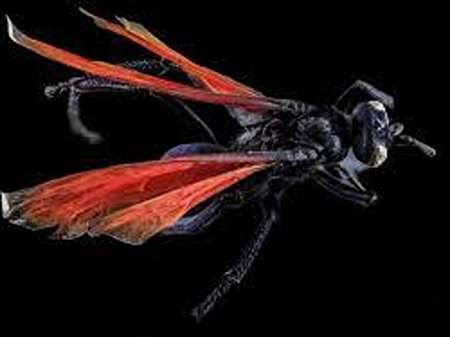
| Common Name | Spider Wasp |
| Scientific Name | Enytpus unifasciatus |
| Size | 0.6-1.3 inches |
| Habitat | Forests, gardens |
| Danger Level | Moderately high |
| Reason | Venomous stings |
Spider Wasps derive their name from their diet, which includes mainly arachnids and nectar. They use venom to paralyze their prey and then drag it to its den, which their larva later uses to feed on.
Spider wasps do not hurt humans in general but may not step back if felt threatened.
15. Black Blister Beetle
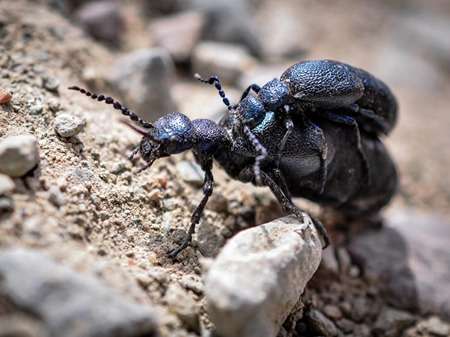
| Common Name | Blister Beetles |
| Scientific Name | Epicauta pennsylvanica |
| Size | 0.3-0.7 inches |
| Habitat | Around flowering plants |
| Danger Level | High |
| Reason | Release chemicals that cause redness, blisters |
Black Blister Beetles are black-colored insects, which have a shiny sheen on its head, and the ad is also on their wings. Though it’s the last member of this list of Bugs in Alaska, its potency should not be underestimated.
As a defense mechanism, black blister beetles release a chemical substance, which on contact with the skin, causes severe irritation, coupled with redness, and later turns into painful blisters.
Now it’s time to conclude this article on 15 dangerous bugs in Alaska. Please do check out our other articles on this website, covering mammals, reptiles, birds, fishes, etc. We will be back soon with more such interesting write-ups, so stay tuned until then.
References:
Insectidentification.org- Western Bumblebee
Insectidentification.org- Paper Wasp
Orkin- Allegheny Mound Ant
Also Read:

A zoology student turned writer. Nature has always been a magnet to me, and to unearth some of its secrets through my articles is my prime intention. If not engaging myself with nature and anime content, you can always find me going through some Bengali classics or filling the air with some soulful Tabla beats. An artist, trying to throw some colors to my blank canvas of life.
